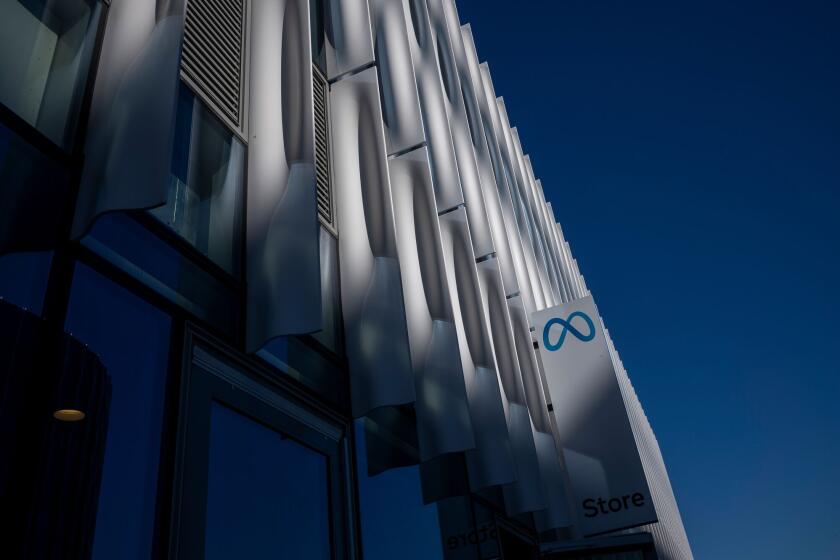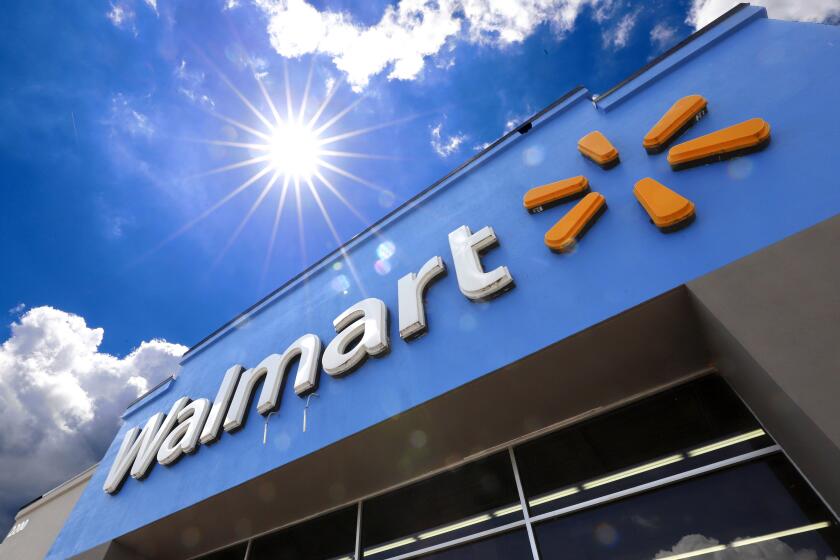Anaheim Plaza: Mall That’s Been Mauled...
- Share via
At first appearance, Anaheim Plaza looks pretty much like any other mall during the holiday season. Santa Claus holds court from a festooned throne. Giant golden sleigh bells hang from the rafters. The aisles overflow with cart vendors.
A closer look, however, reveals why the 35-year-old mall has become the black sheep of Orange County’s retail scene.
The Santa display masks the empty store behind it, a Robinson’s that closed three years ago. Seasonal stores temporarily occupy spaces vacated by well-known retailers such as the Gap, Silverwoods and Miller’s Outpost.
The current bustle, however, is just a Yuletide illusion. The mall’s veteran merchants have suffered through years of declining sales, as newer, brighter malls have prospered. And despite plans for renewal, the outlook is uncertain.
The story of the Anaheim Plaza--one shared by other aging Southland malls--is of tough competition, changing demographics, shifting consumer tastes and management missteps. And while the final chapter is not written, it will be difficult to turn around the plaza’s fortunes.
Opened in 1955 as Anaheim Center, it was among the first in a wave of shopping centers that dotted booming Southern California. It rose in the middle of a housing tract between Euclid Street--Anaheim’s equivalent of Main Street U.S.A.--and the Santa Ana Freeway, the conduit which would funnel auto-happy Southlanders to its shops.
They came to browse in the Broadway, its first anchor store on its southern end. Later, they mosied through Robinson’s on the north end. In between, they could drop into dozens of speciality stores enclosing an open-air courtyard. Through the 1960s, its 3,850-space parking lot bulged with cars.
But toward the end of the decade, Anaheim Center began to show its age. And there were new kids on the block--the malls.
With their gleaming tile floors, high ceilings and hot-dog-on-a-stick stands, the malls enticed customers to their controlled environments--day or night, rain or shine. To stay competitive, Anaheim Center joined the flock.
In 1972, the center’s owner, Prudential Life Insurance Co., spent $4 million on renovations and renamed it the Anaheim Plaza.
Soon the crowds were returning. A Mervyns department store was added as the third anchor. Sales grew at an average yearly rate of 20% from 1974 to 1980, when they were about $60 million.
But other changes were happening around the plaza. Housing and population growth peaked in northern Orange County. Competition increased--three new malls were built nearby and a fourth remodeled. And Prudential put the mall up for sale.
The buyers in 1984 were the State Teachers Retirement System of Sacramento in a joint venture with a Utah developer, for an estimated $33.5 million. The retirement system, which directs the pension fund for the California school teachers, has since become sole owner.
The new owners were more investors than managers. While its competitors dressed up, Anaheim Plaza again began to fall out of fashion. With its dark earth-tone color scheme, undecorated corridors and artificial lighting, the center looked about as modern as a leisure suit.
Mark Jorgensen, a senior investment adviser for the retirement system, declined comment on the management of Anaheim Plaza. But center retailers say the system’s officials have admitted several missteps in meetings with store owners.
Charles Cooper, owner of the Hickory Farms store in the mall, said the plaza’s owners “admitted they bought something they shouldn’t have bought.”
At a recent meeting with tenants, system officials said they had initially hoped to sell it for a quick profit but misjudged the market.
And the competitive pressures just increased. The plaza faced the Brea and Buena Park malls to the north and the City, Mall of Orange, MainPlace/Santa Ana and South Coast Plaza to the south.
Taxable sales at Anaheim Plaza slid from $84 million in 1986 to $56 million last year, a 33% drop. In the same period, the nearby Brea Mall increased its sales from $178 million to $224 million, a 26% rise.
Changing demographics hurt too. The wealth headed to places such as South Orange County and the Anaheim Hills. By 1988, the median income near the Plaza was $35,000, far below the Orange County’s median of $47,000.
Retailers reacted by relocating. Robinson’s, an upscale department store, headed to the more prosperous MainPlace and closed its Anaheim Plaza anchor store in 1987. The defection caused a chain reaction that started the exodus of speciality stores.
Alarmed at the loss of Robinson’s and other stores, the retirement system hired a developer to manage and devise a comeback strategy for the mall. The developer proposed a three-year, $7-million renovation that would have completely updated the mall’s look, adding skylights to an entrance with ceremonial banners. There was talk of two new department stores, a second level of stores and maybe a new hotel.
Meanwhile, city officials, eager to keep one of the city’s only shopping malls and one of its largest taxpayers, commissioned a study of the mall’s potential. The study concluded that the plaza could survive as a “discount center,” particularly if the Broadway were to convert its store into an outlet for final sales merchandise.
Mall officials carted their renovation plans off to a shopping centers convention in May, 1989, to court retailers. But in an abrupt about-face, the retirement system decided instead to put the mall up for sale and stopped signing multi-year leases.
That decision sparked a new round of vacancies of major tenants, who needed assurances they would be able to conduct business for several years. At one point, the vacancy rate climbed to more than 30%. Mall managers tried to fill the spaces the best they could, moving in an Anaheim city museum and school district vocational training center or renting to non-chain shops. Nothing seemed to help.
Alice Denunzio, co-owner of the seasonal Specialty Gift Emporium, said: “The only people who come to this mall are the neighborhood residents (who) refuse to go anywhere else.”
Some retailers complain that they are unable to elicit the retirement system’s attention when they try to point out problems that need to be remedied. Vance H. Ready, owner of Animation Alley Collectibles & Gifts, wrote to the retirement system’s chief executive, James Mosman, in October to report a range of deficiencies, from filthy restrooms to the curtailment of shuttle bus service between the mall and major Anaheim hotels.
Some of the gripes have settled down now that plentiful Christmas season has arrived at the mall, but not the residual bitterness. Cooper said his sales were up this year over last for the four-day Thanksgiving holiday.
He does not mince words, however, in venting his frustration over the lack of improvements at the mall or in finding a new anchor store. “They (the owners) need to come here and put some life into this mall,” Cooper said.
Still, the pension system is beginning to sound serious about renovating Anaheim Plaza. For starters, the owners confirmed that the mall is no longer for sale and is considering renovation plans.
There are other encouraging signs as well.
Mervyns manager Debbie Curtis said the store outsold 10 other company stores in its Orange-South Los Angeles County district during the morning sales on the crucial Friday following Thanksgiving, typically the biggest shopping day of the year. The Mervyns store is slated for a $2-million renovation, with or without mall improvements, she said.
Still, retail and real estate analysts say Anaheim Plaza’s future is far from certain. They say the freeway access problem must be solved and new anchor tenants found. Or the mall should be turned into a theme or “power center,” perhaps focusing on electronics.
Whatever the direction, the mall’s believers are ready for changes. But even that might not be enough: “The rest,” said mall manager Kelso, “is crossed fingers.”
More to Read
Inside the business of entertainment
The Wide Shot brings you news, analysis and insights on everything from streaming wars to production — and what it all means for the future.
You may occasionally receive promotional content from the Los Angeles Times.










